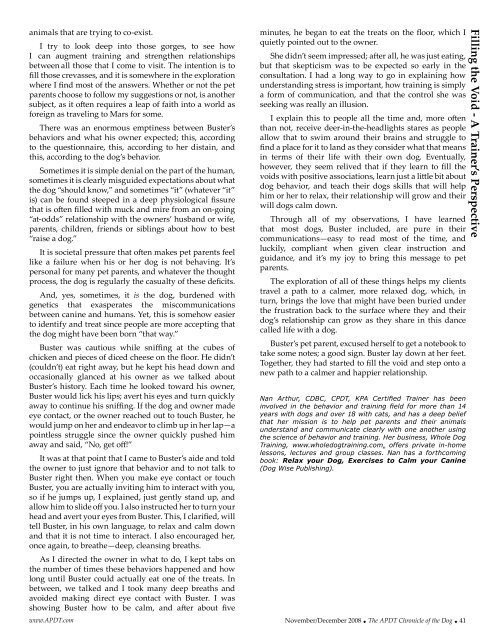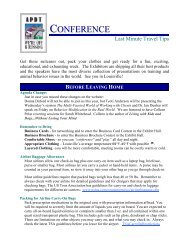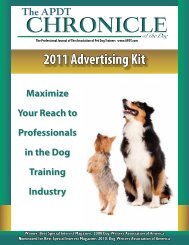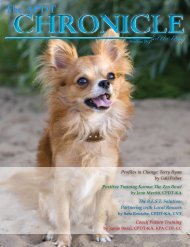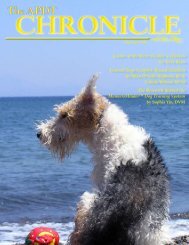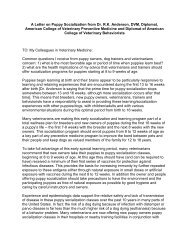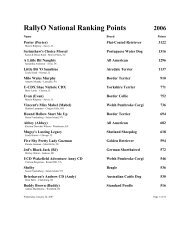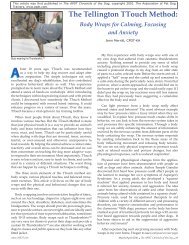of the Dog - Association of Pet Dog Trainers
of the Dog - Association of Pet Dog Trainers
of the Dog - Association of Pet Dog Trainers
You also want an ePaper? Increase the reach of your titles
YUMPU automatically turns print PDFs into web optimized ePapers that Google loves.
animals that are trying to co-exist.<br />
I try to look deep into those gorges, to see how<br />
I can augment training and streng<strong>the</strong>n relationships<br />
between all those that I come to visit. The intention is to<br />
fill those crevasses, and it is somewhere in <strong>the</strong> exploration<br />
where I find most <strong>of</strong> <strong>the</strong> answers. Whe<strong>the</strong>r or not <strong>the</strong> pet<br />
parents choose to follow my suggestions or not, is ano<strong>the</strong>r<br />
subject, as it <strong>of</strong>ten requires a leap <strong>of</strong> faith into a world as<br />
foreign as traveling to Mars for some.<br />
There was an enormous emptiness between Buster’s<br />
behaviors and what his owner expected; this, according<br />
to <strong>the</strong> questionnaire, this, according to her distain, and<br />
this, according to <strong>the</strong> dog’s behavior.<br />
Sometimes it is simple denial on <strong>the</strong> part <strong>of</strong> <strong>the</strong> human,<br />
sometimes it is clearly misguided expectations about what<br />
<strong>the</strong> dog “should know,” and sometimes “it” (whatever “it”<br />
is) can be found steeped in a deep physiological fissure<br />
that is <strong>of</strong>ten filled with muck and mire from an on-going<br />
“at-odds” relationship with <strong>the</strong> owners’ husband or wife,<br />
parents, children, friends or siblings about how to best<br />
“raise a dog.”<br />
It is societal pressure that <strong>of</strong>ten makes pet parents feel<br />
like a failure when his or her dog is not behaving. It’s<br />
personal for many pet parents, and whatever <strong>the</strong> thought<br />
process, <strong>the</strong> dog is regularly <strong>the</strong> casualty <strong>of</strong> <strong>the</strong>se deficits.<br />
And, yes, sometimes, it is <strong>the</strong> dog, burdened with<br />
genetics that exasperates <strong>the</strong> miscommunications<br />
between canine and humans. Yet, this is somehow easier<br />
to identify and treat since people are more accepting that<br />
<strong>the</strong> dog might have been born “that way.”<br />
Buster was cautious while sniffing at <strong>the</strong> cubes <strong>of</strong><br />
chicken and pieces <strong>of</strong> diced cheese on <strong>the</strong> floor. He didn’t<br />
(couldn’t) eat right away, but he kept his head down and<br />
occasionally glanced at his owner as we talked about<br />
Buster’s history. Each time he looked toward his owner,<br />
Buster would lick his lips; avert his eyes and turn quickly<br />
away to continue his sniffing. If <strong>the</strong> dog and owner made<br />
eye contact, or <strong>the</strong> owner reached out to touch Buster, he<br />
would jump on her and endeavor to climb up in her lap—a<br />
pointless struggle since <strong>the</strong> owner quickly pushed him<br />
away and said, “No, get <strong>of</strong>f!”<br />
It was at that point that I came to Buster’s aide and told<br />
<strong>the</strong> owner to just ignore that behavior and to not talk to<br />
Buster right <strong>the</strong>n. When you make eye contact or touch<br />
Buster, you are actually inviting him to interact with you,<br />
so if he jumps up, I explained, just gently stand up, and<br />
allow him to slide <strong>of</strong>f you. I also instructed her to turn your<br />
head and avert your eyes from Buster. This, I clarified, will<br />
tell Buster, in his own language, to relax and calm down<br />
and that it is not time to interact. I also encouraged her,<br />
once again, to brea<strong>the</strong>—deep, cleansing breaths.<br />
As I directed <strong>the</strong> owner in what to do, I kept tabs on<br />
<strong>the</strong> number <strong>of</strong> times <strong>the</strong>se behaviors happened and how<br />
long until Buster could actually eat one <strong>of</strong> <strong>the</strong> treats. In<br />
between, we talked and I took many deep breaths and<br />
avoided making direct eye contact with Buster. I was<br />
showing Buster how to be calm, and after about five<br />
www.APDT.com<br />
minutes, he began to eat <strong>the</strong> treats on <strong>the</strong> floor, which I<br />
quietly pointed out to <strong>the</strong> owner.<br />
She didn’t seem impressed; after all, he was just eating,<br />
but that skepticism was to be expected so early in <strong>the</strong><br />
consultation. I had a long way to go in explaining how<br />
understanding stress is important, how training is simply<br />
a form <strong>of</strong> communication, and that <strong>the</strong> control she was<br />
seeking was really an illusion.<br />
I explain this to people all <strong>the</strong> time and, more <strong>of</strong>ten<br />
than not, receive deer-in-<strong>the</strong>-headlights stares as people<br />
allow that to swim around <strong>the</strong>ir brains and struggle to<br />
find a place for it to land as <strong>the</strong>y consider what that means<br />
in terms <strong>of</strong> <strong>the</strong>ir life with <strong>the</strong>ir own dog. Eventually,<br />
however, <strong>the</strong>y seem relived that if <strong>the</strong>y learn to fill <strong>the</strong><br />
voids with positive associations, learn just a little bit about<br />
dog behavior, and teach <strong>the</strong>ir dogs skills that will help<br />
him or her to relax, <strong>the</strong>ir relationship will grow and <strong>the</strong>ir<br />
will dogs calm down.<br />
Through all <strong>of</strong> my observations, I have learned<br />
that most dogs, Buster included, are pure in <strong>the</strong>ir<br />
communications—easy to read most <strong>of</strong> <strong>the</strong> time, and<br />
luckily, compliant when given clear instruction and<br />
guidance, and it’s my joy to bring this message to pet<br />
parents.<br />
The exploration <strong>of</strong> all <strong>of</strong> <strong>the</strong>se things helps my clients<br />
travel a path to a calmer, more relaxed dog, which, in<br />
turn, brings <strong>the</strong> love that might have been buried under<br />
<strong>the</strong> frustration back to <strong>the</strong> surface where <strong>the</strong>y and <strong>the</strong>ir<br />
dog’s relationship can grow as <strong>the</strong>y share in this dance<br />
called life with a dog.<br />
Buster’s pet parent, excused herself to get a notebook to<br />
take some notes; a good sign. Buster lay down at her feet.<br />
Toge<strong>the</strong>r, <strong>the</strong>y had started to fill <strong>the</strong> void and step onto a<br />
new path to a calmer and happier relationship.<br />
Nan Arthur, CDBC, CPDT, KPA Certified Trainer has been<br />
involved in <strong>the</strong> behavior and training field for more than 14<br />
years with dogs and over 18 with cats, and has a deep belief<br />
that her mission is to help pet parents and <strong>the</strong>ir animals<br />
understand and communicate clearly with one ano<strong>the</strong>r using<br />
<strong>the</strong> science <strong>of</strong> behavior and training. Her business, Whole <strong>Dog</strong><br />
Training, www.wholedogtraining.com, <strong>of</strong>fers private in-home<br />
lessons, lectures and group classes. Nan has a forthcoming<br />
book: Relax your <strong>Dog</strong>, Exercises to Calm your Canine<br />
(<strong>Dog</strong> Wise Publishing).<br />
November/December 2008 w The APDT Chronicle <strong>of</strong> <strong>the</strong> <strong>Dog</strong> w 41<br />
Filling <strong>the</strong> Void - A Trainer’s Perspective


